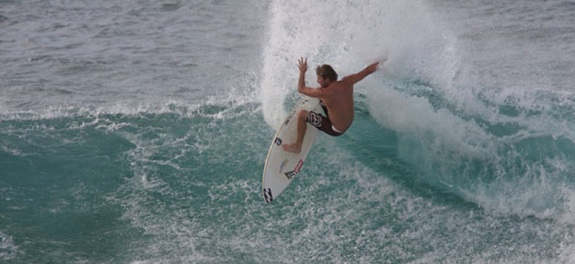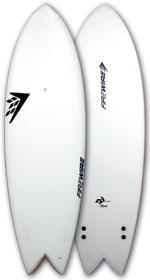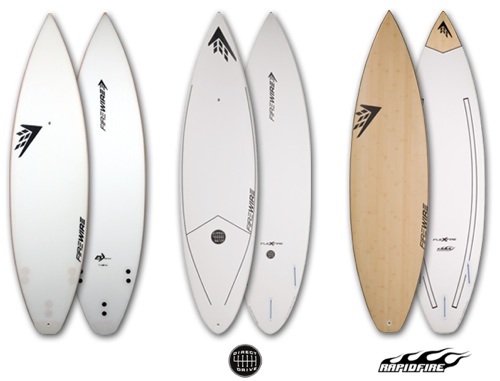 If you haven’t been up on surfboard technology, things have changed. In 2005, Clark Foam, the largest foam blank supplier closed its doors citing new environmental regulations which would have crippled its business. The standard for surfboards since the late 50’s when polyurethane foam and fiberglass-resin boards replaced wood boards, had come to an end.
If you haven’t been up on surfboard technology, things have changed. In 2005, Clark Foam, the largest foam blank supplier closed its doors citing new environmental regulations which would have crippled its business. The standard for surfboards since the late 50’s when polyurethane foam and fiberglass-resin boards replaced wood boards, had come to an end.
 Opening up the market to new innovations and materials, San Diego based Firewire Surfboards was ready with their new carbon and bamboo creation. Lighter, stronger and more flexible, Firewire’s boards are also more eco friendly emitting only 2 percent of volatile organic compounds and are 50 times less toxic to the environment than polyurethane foam. No masks are needed around this stuff, and you can walk into any of their factories without getting an instant headache.
Opening up the market to new innovations and materials, San Diego based Firewire Surfboards was ready with their new carbon and bamboo creation. Lighter, stronger and more flexible, Firewire’s boards are also more eco friendly emitting only 2 percent of volatile organic compounds and are 50 times less toxic to the environment than polyurethane foam. No masks are needed around this stuff, and you can walk into any of their factories without getting an instant headache.
Using an environmental sensitive laminating process, the Rapidfire line uses basic cooler type EPS (Expanded Polystyrene) foam inlaid with carbon rods for flex and topped with finished bamboo for strength and stiffness, replacing the standard wood stringer. All excess EPS foam is recycled at the end of the building process. They even won the coveted EuroSIMA Environmental Product of the Year Award in 2005.

Much like Patagonia’s eco-friendly surfing wetsuits, surfing technology is being pushed into the future, with an eco-friendly and sustainable goal shared by surfers alike. Hopefully Firewire along with other surfboard companies will develop even better and more environmentally friendly surfboards in the years to come – I’m counting on it.
Comments 2
Pingback: Finisterre UK Surf Clothing | The Chic Ecologist
Surfing has been around for many generations. As with any culture that is passed down, tradition will be altered from its original state. For better or worse, these changes in tradition continue to shape the future, and specifically, the future of surfing. I see that many people that live their lives around the waves, or are currently apart of the surfing culture, are often unaware of the old tradition, such as the history of the board beneath their feet. This naivety results in negative consequences, not only for the surfing culture, but for the environment. One controversial topic that has plagued surfing culture throughout its history, is surfboard material. Initially, the surfboards were made of wood, but now majority of the boards are made of either polyester, epoxy, or polyurethane. A surfboard should be made out of Balsa wood due to its surfing characteristics, sustainability, and impact on the environment.
Few current generation surfers realize the true environmental impact of the board beneath their feet. A shocking fact is that an EPS/Epoxy surfboard creates 1000 pounds of CO2e which is more than a commercial flight from LAX to Honolulu Hawaii. The real importance of this figure is brought out by National Geographic, when examining carbon’s effect on the atmosphere. “Carbon dioxide, a greenhouse gas, is the main pollutant that is warming Earth” (“Air Polution Comes From Many Sources”) Global warming, and its causes is a whole discussion in itself, but all can agree that it would be wise to cut down on carbon emissions.
All of these carbon statistics are not even considering the negative effects when disposing of the foam, such as the decomposition time. It is clear that polyester, epoxy, and polyurethane are not environmentally friendly surfboard material choices, and another material needs to be substituted.
When looking for alternate materials three criteria need to be met. The material must be eco-friendly, not creating large amounts of pollution; high-performance, maintaining the characteristics of modern foam boards; and economically friendly, costing about the same as a modern board. Few materials meet all three criteria.
Discover Riley Balsa Wood Surfboards. The core of our surfboards, and therefore their main component, is Balsa wood (Ocroma Pyramidale). Balsa is the lightest wood of all and was already used as a transport float in South America 1000 years before the Inca Empire. This plant is one of the fastest growing species, reaching a height of up to 10 metres and a diameter of 20-25 cm within 3-4 years.
The Balsa trees are planted in a sustainable mixed cultivation program together with bananas, yucca and beans.
The production of foam blanks has an extremely negative effect on the environment by using fossil fuels and toxic ingredients in the production process. Moreover, the final product can hardly be recycled and therefore contributes to pollution in soil and drinking water.
By contrast, Balsa wood is a fast growing, sustainable and recyclable raw material, producing no toxic substances. Therefore, it can be safely said that the use of Balsa wood is a sustainable way of producing surfboard blanks.